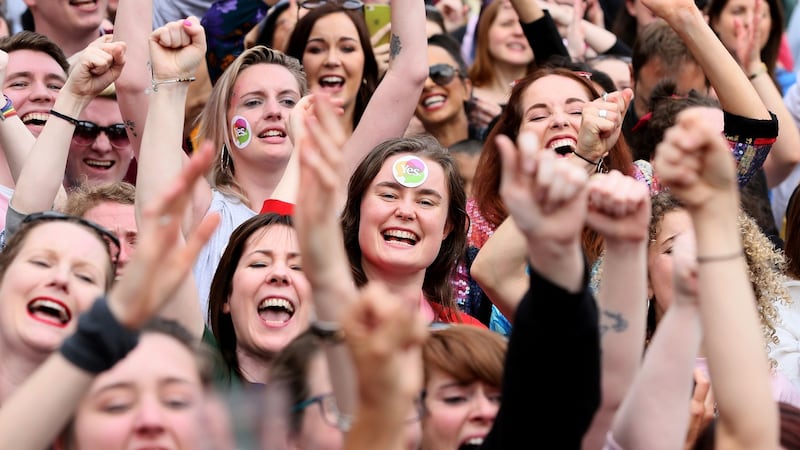I watched the progress of the campaign to repeal the Eighth Amendment through the eyes of an “old soldier” of the 1983 campaign against its original inclusion in the Constitution. I remember the organised groups who came along then to shout down anyone who dared speak aloud, or worse still in public, against the proposed amendment, which was finally and completely to prevent abortion in Ireland. I remember the anonymous letters we received. I remember the phone calls to my home. I was a member of the Senate then.
Years later, a legal academic interviewed some members of the Oireachtas who had been involved in that anti-amendment campaign. Almost without exception they just did not want to talk about it. They simply could not bear to resurrect those memories.
The advantage of the Together4Yes campaign was its unity. This was one of the lessons learned from the Marriage Equality campaign of 2015
Since 1983 we have revisited the Eighth Amendment more than once. In 1992, after the X case and the Society for the Protection of Unborn Children cases against the student unions we approved the Thirteenth and Fourteenth Amendments to permit travel to another jurisdiction and the provision of information on services lawful in another state. At the time, both these changes were rigorously opposed by the defenders of the Eighth Amendment. They seem to be more or less accepted by them now.
Atmosphere of respect
This year’s campaign was different. While both sides were passionately convinced of the rightness of their respective causes, and while the poster war was fairly ferocious, there was an atmosphere of relative respect. Personal abuse was very rare. With the exception of Claire Byrne’s programme, television and radio debates were well-controlled. I must admit to ignorance of the war online, which in any case was affected by the decisions of Facebook and Google.
The advantage of the Together4Yes campaign was its unity. This was one of the lessons learned from the Marriage Equality campaign of 2015. It was seen from the beginning that there was a wide spread of opinion among the advocates of repeal and that argument between the disparate groups could only lead to a bitter defeat. There was also an understanding that abortion itself was a sensitive and difficult subject. It was going to be less “happy” than marriage equality. During the campaign I spoke personally to people of all shades of opinion and of all ages. What they sought through repeal of the Eighth Amendment was trust in women, freedom of choice for women and men to make their own decisions in their own family, a rejection of State or religious control – all manner of aims. No one sought to promote abortion as such. The warning by the No side that Ireland would rapidly reach English levels was firmly rejected. The well-worn floodgates argument had lost its effect.

What was less obvious was the level of work that was done behind the scenes in preparation for the Together4Yes campaign. Bringing together the opinions of disparate groups and individuals cannot have been easy. But by the time I spoke at the official launch of the campaign in the Pillar Room of the Rotunda, the effect of this preparation was clear. Working together continued well through the campaign. A real encouragement was the success of the crowd funding – in contrast to the poverty-stricken campaign of 1983. Giving money meant serious commitment. So did the wonderful crowd of voluntary canvassers who left no door unknocked.
Tooth and nail
In the No campaign also different groups worked well together in general but towards the end of the campaign some cracks began to show. The most remarkable of these was acceptance, if not praise, for the Protection of Life in Pregnancy Act (the 2013 Act) by some of the No spokespersons. When that Act as a Bill came before the Joint Oireachtas Committee of the time, the supporters of the Eighth Amendment fought it tooth and nail. At one of that committee’s hearings, I gave legal support to the Bill. My legal opponent on that day was Prof William Binchy. The suggestion in the last weeks of the campaign that the so-called hard cases could be dealt with by a minor amendment to the Eighth Amendment was not properly thought through and had an air of the last ditch.
What they sought through repeal was trust in women, freedom of choice for women and men to make their own decisions in their own family, a rejection of State or religious control. No one sought to promote abortion as such
Did we in the Yes campaign foresee the extent of the majority? Not many of us, I think. In the middle of Friday night, I was listening to the BBC World Service. The exit poll result of the referendum in Ireland was the top item on their world news. I could not resist a moment of triumph, after all the 35 years. The scene in Dublin Castle on Saturday was amazing – faces full of delight, euphoria and at least some astonishment. There was real joy in the meeting of the men and women of 1983. I exchanged memories with Brendan Howlin who had shared with me the fight to defeat the amendment legislation in the Senate. We had so nearly won then. It has been a long 35 years.
To the No campaign supporters we have to offer sympathy – we know what it feels like to lose.
Catherine McGuinness was a member of the Supreme Court between 2000 and 2006 and campaigned against the Eighth Amendment in 1983









